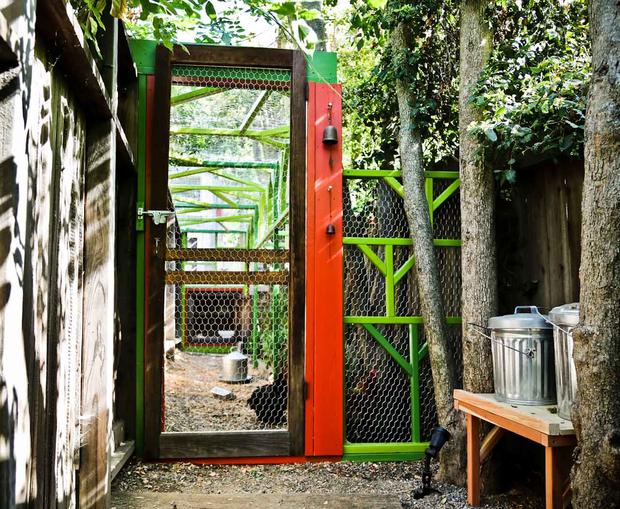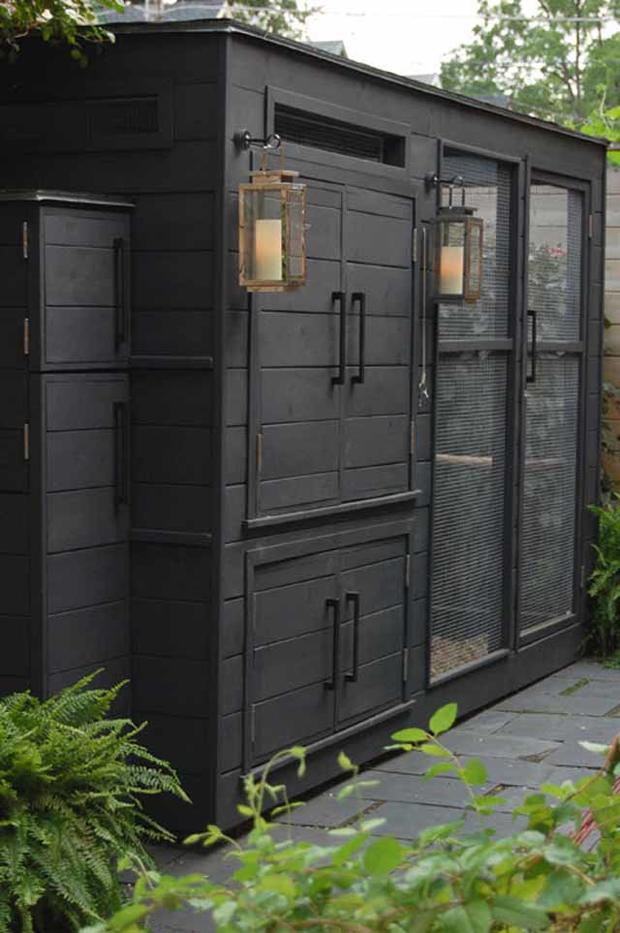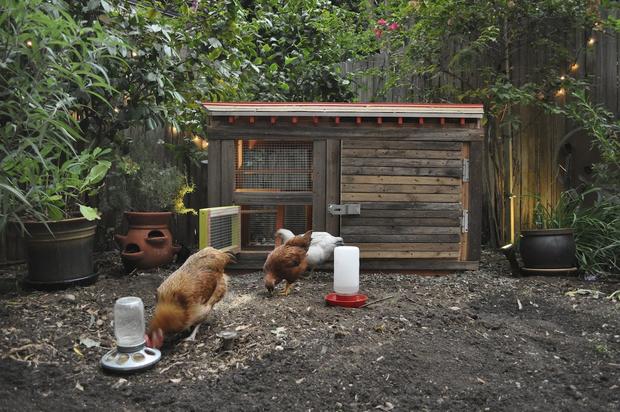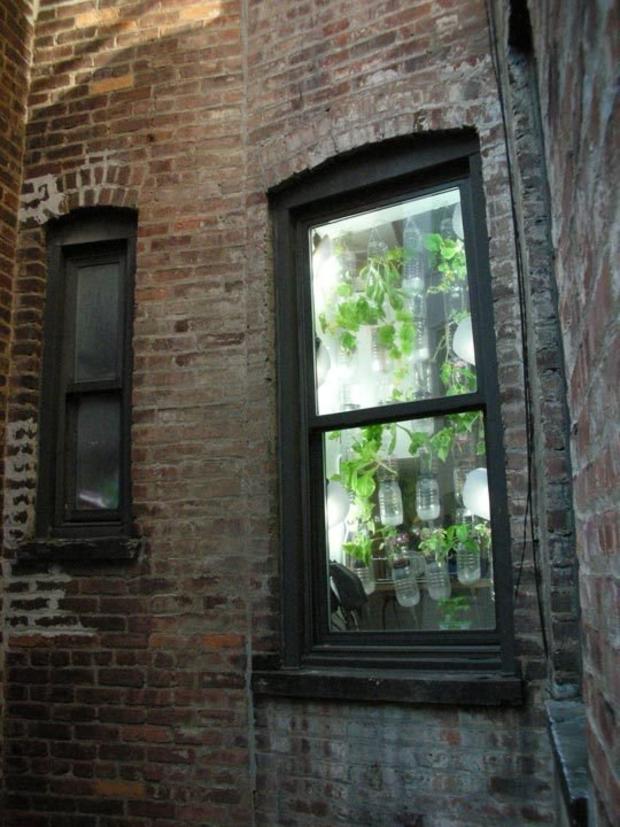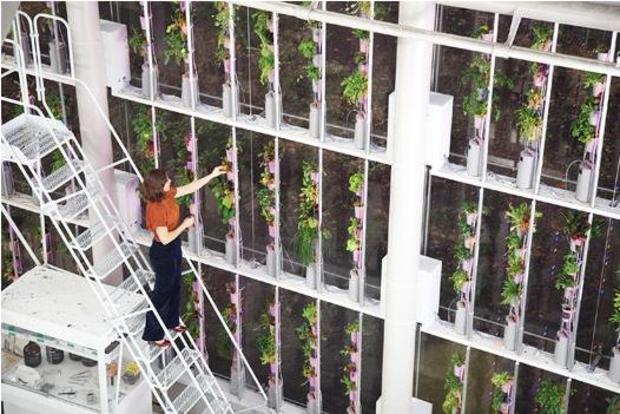7 elaborate urban farms
Photo by Irwin Miller
It's possible to become a real farmer with 25 square feet of space, even if skyscrapers are your neighbors.
But it does take a bit of planning and innovation. Luckily, there is a core group of artists, designers and farmers leading the charge to help city-dwellers lower their food costs, eat local and turn their urban homes into homesteads.
Britta Riley, a young artist and technologist, turned her small Brooklyn apartment window and some water bottles into a prototype for a hydroponic window farming system. It started by yielding one salad's worth of veggies per week and ended up in the American Museum of Natural History, thanks to her sleek and modern design that once looked like an elaborate web of water bottles. Artist Fritz Haeg started an Edible Estates project that transformed 15 useless front lawns from Kansas to Istanbul into agricultural marvels worthy of places like the Tate Modern museum in London.
With the "moderate cost" of food for the average 19 to 50-year-old man in the U.S. at $295.90 per-month, according to the USDA, why wouldn't you want to feed yourself from the land where you're already paying to live? Plus, filling an urban space full of leafy vegetables, fruit trees, roosting chickens and buzzing bees is a lot more beautiful than covering one in concrete.
Here are seven city-dwellers who are doing just that.
Kelly and Erik's Los Angeles homestead
Photo by Emily Ho
Kelly Coyne and Erik Knutzen practice what they call "radical home ec." Their Los Angeles home, which is often featured on their homesteading blog Root Simple, features a 1/12th-acre lot with bee hives, a chicken coop, fruit trees, vegetables, a rain barrel, a twig-burning stove, a solar dehydrator and compost bins. The couple makes a point of putting everything in their garden to good use, creating beauty and cleaning products, drinks and homegrown food dishes from what they harvest.
City Farmer's edible walls in Vancouver
Photo by Michael Levenston, courtesy of City Farmer
If you lived in an area that wasn't exactly a food oasis, and you didn't have enough space or skills to grow food in the traditional way, it could drive you up a wall. City Farmer, a Vancouver, British Columbia-based agriculture group founded in 1978, understood this and figured out a way to farm vertically and easily in places people could use more produce.
This edible wall was installed by the local Environmental Youth Alliance's Green Graffiti project with the help of nonprofit Raincity Housing in downtown Vancouver. It's on the side of the Princess Rooms, a housing center specializing in providing safe housing for people who are chronically homeless.
City Farmer's metal, soil-filled container units, which are custom built to support the vertical gardens, support wildlife as much as they support people. The green spaces they create nurture insects like ladybugs and monarch butterflies.
Karen's DIY, double-decker chicken coop
Photo by Karen Bertelsen
Karen Bertelsen, an Ontario, Canada-based television host who has been featured on HGTV shows like "Handyman Superstar Challenge," does a lot of stuff. On her blog, The Art of Doing Stuff, she documents her numerous household DIY projects and instructs readers on how to live like a "frugal alpha monkey."
In April 2011, when Bertelsen's boyfriend presented her with the gift of six chicks for Easter, she realized she needed a place to put them. Inspired by an urban coop built by Portland architects Mitchell Snyder and Shelley Martin, as well as Country Living Magazine stylist Heather Bullard's SoCal Chez Poulet, Bertelsen took a few months to build this beautiful-but-practical double-decker chicken coop for her new feathered friends. It features an exterior nesting box, gates that close with Rare Earth magnets to keep out predators, lots of storage, a skylight and large screens so she can see them from her dining room.
The Miller family's backyard farm
Photo by Irwin Miller
For architect Irwin Miller and his family in Los Angeles, one kindergarten school project turned into a whole lot of eggs. His son's class hatched chicks, and when it came time to find them homes the Millers volunteered.
"We started with a wood wine case and heat lamp as their first home and then migrated to a used bookcase on its side, with chicken wire along the top," Miller said in an ApartmentTherapy interview. "Finally, I realized it was time to build a formal house or coop for them."
Miller built the main frame of the chicken house out of repurposed wood framing he had around the house and got some wood for the façade from his neighbor. The finished product ended up being roughly 2-feet by 4-feet by 4-feet -- the perfect size for the family's three hens. He painted the windows and other openings lime green and persimmon red for a pop of backyard color.
The Foti family's Edible Estate
Photo by Fritz Haeg
Fritz Haeg is a Los Angeles-based artist who doesn't like grass. His Edible Estates project, which he launched in 2005, sought to transform water-wasting, grass-covered front lawns into food-producing gardens.
Jennifer and Michael Foti, a couple living in the Los Angeles suburb Lakewood, caught wind of Haeg's efforts and contacted him:
"Our lawn is flat, gets plenty of sunlight, and is totally pesticide-free," Michael Foti wrote in an email. "It's also one of the brownest on the street, as my wife refuses to waste water on it."
Haeg thought they were good candidates for a veggie lawn upgrade, brought volunteers into the Fotis' 20-foot by 38-foot yard and covered the expenses. Now, the Fotis have a thriving garden with tomatoes, beans, squash, eggplants and other edibles that they can share with both supportive and skeptical neighbors. The family also maintains a chicken coop in the backyard.
Britta's Brooklyn Windowfarm
Photo by Britta Riley, courtesy of Windowfarms
When Britta Riley moved to Brooklyn from rural Texas, she wanted to grow her own food. When her limited access to outdoor space presented a problem, Riley and her friend Rebecca Bray rigged up this prototype for a vertical hydroponic vegetable garden -- made of water bottles, a water pump and a bucket -- that she could hang in the window. The first Windowfarm held 25 plants and grew vegetables like beans, cucumbers, basil and kale.
But from there, they decided to think bigger. Riley launched an online forum to get advice that would improve her design and share her thoughts with other would-be apartment farmers. In 2011, Windowfarms became a company.
Britta's Brooklyn Windowfarm
Photo by Justin Steele
"We still maintain a website that shows people how to make their own out of water bottles for about $150 and a few days' work," Riley said. "But ultimately we moved away from upcycling water bottles when we found that manufacturing a product sustainably both decreased the environmental impact and opened the home food growing experience to a wider segment of the public."
Riley and Bray launched a successful Kickstarter campaign to manufacture Windowfarms as a product, and what was once an apartment DIY project is now in thousands of homes in the U.S. and Canada, as well as institutions such as The American Museum of Natural History and the headquarters for National Geographic.
Seth and Elena’s San Francisco micro-garden
Photo by Seth Boor
Seth Boor and Elena DiMuzio may have a small San Francisco backyard -- about 25 square feet with a driveway in the middle -- but they make the most of it with good planning and lots of fruit trees and shrubs. Their garden yields several varieties of apples, figs, pineapple guava, Asian pears, currents, persimmons, plums and other succulent and flowering plants.
Boor is an architect, and appreciates the challenge of adapting to his relatively small farming environment. DiMuzio enjoys making the garden beautiful as well as practical with roses and hellebore flowers.
But when Boor and DiMuzio go outside, they both get to enjoy a bit of local history. The stacked stone forming their vegetable bed was repurposed after its previous use on old San Francsico streets.
